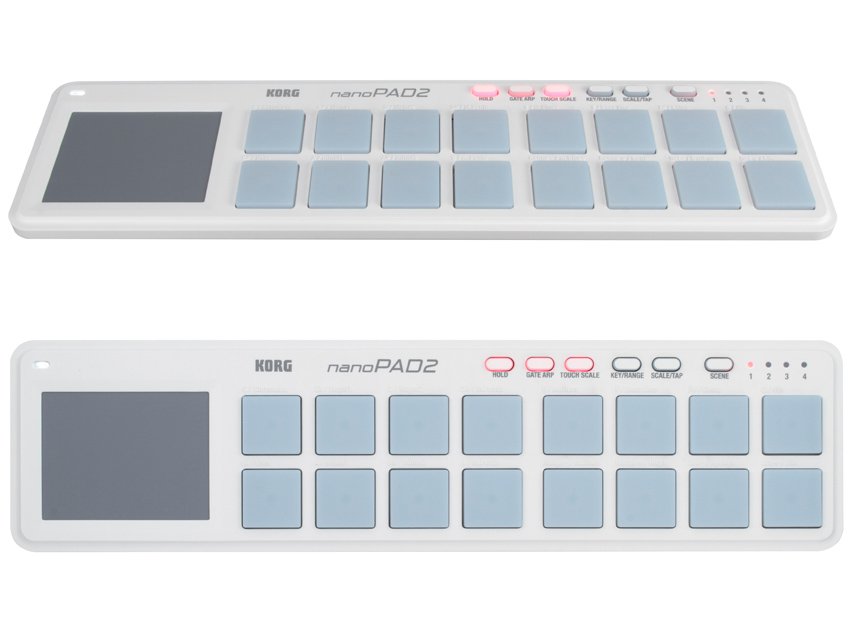MusicRadar Verdict
The new hardware looks and feels better, though some may be disappointed that certain features have been left behind.
Pros
- +
Improved design and build. New performance modes. Highly affordable.
Cons
- -
Some functionality lost from first series.
MusicRadar's got your back
Korg's original nanoSeries kickstarted the super-compact MIDI controller concept in late 2008, and competitor Akai responded with their slimline LPD8 and LPK25 units.
Korg now returns fire with the nanoSeries 2, which comprises three units. All are USB-powered class-compliant MIDI devices, meaning that you just plug them in and off you go - no need for drivers or external power supplies.
"The original nanoPad pleased us greatly with its sturdy, responsive drum pads. Now, they've grown in number from 12 to 16."
A sleeker and more rounded-out design makes the devices easier on the eye and in-keeping with the current trend for softer aesthetics.
Paddywhack
The original nanoPad pleased us greatly with its sturdy, responsive drum pads. They've grown in number from 12 to 16, with a slight separation down the middle, effectively presenting them as two banks of eight.
The Flam and Roll buttons have been replaced with Gate Arp, Touch Scale, Key/Range and Scale/Tap options. These are performance-oriented controls for use in conjunction with the excellent X/Y pad.
In its standard mode, the X/Y pad transmits CCs; in Touch Scale mode, the X axis instead sends notes while the Y controls note length. Thus you can play musical patterns and phrases, much like on Korg's Kaossilator series.
Scales and keys are accessible via the Key/Range and Scale/Tap buttons - while holding one of these down, you can select notes and scales by pressing the pads.
Want all the hottest music and gear news, reviews, deals, features and more, direct to your inbox? Sign up here.
Gate Arp creates rhythmic 'gated' notes at a specified tempo (set via tap tempo or synced to MIDI). You hold a pad and use the X/Y pad to control the rate - ideal for glitchy effects or basic drum rolls. By engaging Touch Scale mode, you can play gated melodies on the X/Y pad.
There are four bank select buttons, making a total of 64 'virtual' pads. With each able to trigger up to four notes at once (ie, chords), the nanoPad has melodic potential aplenty.
Editor's choice
The full feature-set of the original nanoSeries could only be accessed via the Kontrol Editor software, and this is still the case. There are a few changes for the new devices, though.
On the nanoPad, each pad can send four notes, CCs or program changes, as opposed to the original's eight. Per-pad options to determine whether a pad is included when using the gated modes. The X/Y pad can also be assigned as you like, although this is now global and not per scene.
Note that you can download the Kontrol Editor before buying a nanoDevice to get a feel for its mapping possibilities.
The original nanoSeries turned out to be nifty companions for Apple's iPad, and this holds true. Apps that support Core MIDI (eg, GarageBand and Akai SynthStation) should work just fine.
Korg's own iElectribe and iMS20 apps sport a 'nano 2 native' mode, which will assign the controls appropriately when you plug in a nanoPad. Just be sure to disable this if you want your custom mapping to remain!
Some decent new functionality and a gentle makeover sees the nanoSeries heading in the right direction. However, fans of the first nanoSeries might be annoyed that certain features have been ditched to make way for new ones, rather than the existing feature-set being expanded.
Computer Music magazine is the world’s best selling publication dedicated solely to making great music with your Mac or PC computer. Each issue it brings its lucky readers the best in cutting-edge tutorials, need-to-know, expert software reviews and even all the tools you actually need to make great music today, courtesy of our legendary CM Plugin Suite.

